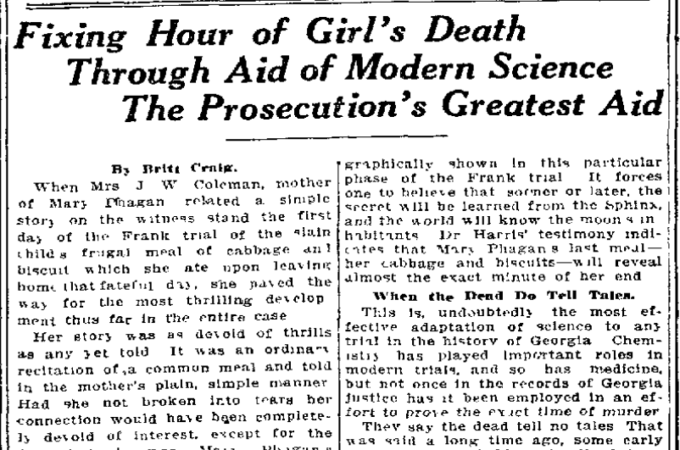Sunday, 3rd August 1913 Fixing Hour of Girl’s Death Through Aid of Modern Science The Prosecution’s Greatest Aid
Atlanta Constitution
August 3rd, 1913
By Britt Craig.
When Mrs. J. W. Coleman, mother of Mary Phagan, related a simple story on the witness stand the first day of the Frank trial of the slain child's frugal meal of cabbage and biscuit which she ate upon leaving home that fateful day, she paved the way for the most thrilling development thus far in the entire case.
Her story was as devoid of thrills as any yet told. It was an ordinary recitation of a common meal and told in the mother's plain, simple manner. Had she not broke into tears her connection would have been completely devoid of interest, except for the fact that she was Mary Phagan's mother.
But her statement of the meal the murdered child had eaten, prepared an opening for the startling testimony of Dr. Roy F. Harris, the state chemist, who testified that the cabbage found in the stomach, and which Mrs. Coleman stated the child had eaten at the noon meal, indicated that she had met her death within 45 minutes after eating.
And another extraordinary incident for which the trial has been peculiarly noted. The biggest thrill of the case was created by two ordinary vials that looked as though they had once contained substance no more interesting than household vaseline which were produced by Dr. Harris—the vials containing the 160 cubic centimeters of cabbage removed from the girl's body.
Morbid Curiosity of Audience.
There was a straining of necks. Many arose from their seats. Women and girls looked on eagerly, expectantly, intent upon missing none of the details. A silence prevailed that could almost be felt and only the buzzing of the fans and ozonators could be heard.
Dr. Harris' testimony was grewsome—harrowingly so. An air of tragedy pervaded the room as he spoke in the terse, crisp words of the medical expert. As he spoke of exhuming the body at dawn in the little Marietta grave yard and of cutting into the child's skull to examine the brain, there were visible shudders throughout the crowded room. Many women left their seats walking hurriedly to the exit, hiding their features with newspapers.
When Mrs. Coleman told of Mary's last meal many wondered why the solicitor introduced such apparently trivial evidence. It irritated them to listen to such unimportant statements while there were more thrilling ones to follow. Inwardly, they no doubt rebuked the prosecutor for dallying with such a story.
But a lasting lesson was learned upon the introduction of Dr. Harris—a lesson of how big sometimes are the infinitesimally small and seemingly inconsequential things of life and mystery.
The trend of modern science is graphically shown in this particular phase of the Frank trial. It forces one to believe that sooner or later, the secret will be learned from the Sphinx, and the world will know the moon's inhabitants. Dr. Harris' testimony indicates that Mary Phagan's last meal—her cabbage and biscuits—will reveal almost the exact minute of her end.
When the Dead Do Tell Tales.
This is, undoubtedly, the most effective adaptation of science to any trial in the history of Georgia Chemistry has played important roles in modern trials, and so has medicine, but not once in the records of Georgia justice has it been employed in an effort to prove the exact time of murder.
They say the dead tell no tales. That was said a long time ago, some early philosopher probably, who lived in a period when science was in swaddling clothes. It is true enough, but should be changed. Dead men speak no tales, would be better, for it is about to be proved that the corpse of Mary Phagan is disclosing the hour of her death.
Probably the discovery of Dr. Harris' was a result of infinite thought and patience. Probably it was an accident. Anyway, he exhumed the body of the murdered child, examined her stomach and found the undigested cabbage. His medical knowledge told him of the length the digestive organs require to act upon this certain vegetable, and this same knowledge told him of how long it had been within the stomach before death.
He informed the solicitor and the solicitor learned from Mrs. Coleman the exact hour at which Mary ate diner. From this summing up of conditions and circumstances and science, Dr. Harris gathered that the girl had been slain not more than forty-five minutes after she had quit the meal.
It is very simple, but a product of science. Mrs. Coleman's simple tale of Mary's dinner of cabbage and biscuit, was the genesis of the most scientific move made in a courtroom in Georgia's history. It was the first link, and without it, the other links could not have been attached to the chain.
But, as is characteristic of the typical courtroom audience, it fretted at such obviously unnecessary testimony relating to what a child ate for dinner.
* * *
T
